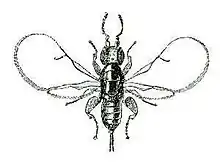Agaonidae
The family Agaonidae is a group of pollinating and nonpollinating fig wasps. They spend their larval stage inside the fruits of figs. The pollinating wasps (Agaoninae, Kradibiinae, and Tetrapusiinae) are the mutualistic partners of the fig trees. The non-pollinating fig wasps are parasitoids. Extinct forms from the Eocene and Miocene are nearly identical to modern forms, suggesting that the niche has been stable over geologic time.[1]
| Agaonidae Temporal range: | |
|---|---|
 | |
| Blastophaga psenes | |
| Scientific classification | |
| Domain: | Eukaryota |
| Kingdom: | Animalia |
| Phylum: | Arthropoda |
| Class: | Insecta |
| Order: | Hymenoptera |
| Superfamily: | Chalcidoidea |
| Family: | Agaonidae Walker, 1848 |
| Subfamilies | |
Taxonomy
The family has changed several times since its taxonomic appearance after the work of Francis Walker in 1846[2] described from the wasp genus Agaon. Previously the subfamilies Epichrysomallinae, Otitesellinae, Sycoecinae, Sycoryctinae, Sycophaginae, and Agaoninae were the subdivisions of the family.[3] Recent works building strong molecular phylogenies with an extended sampling size have changed the composition of Agaonidae. First, the paraphyletic groups have been excluded (Epichrysomallinae, Otitesellinae, Sycoecinae, and Sycoryctinae) and new subfamilies have been instated (Kradibiinae and Tetrapusiinae).[4] Then the subfamily Sycophaginae have been placed within the family Agaonidae.[5] Within the Sycophaginae, some changes were made after the molecular phylogeny of the subfamily:[6] the genus Apocryptophagus has been synonymed under the genus Sycophaga.
Ecology
Wasps from the three subfamilies Agaoninae, Kradibiinae and Tetrapusiinae are pollinating fig wasps. On the other hand, Sycophaginae are parasites of the Ficus, developing in the fruits after other wasps have pollinated them. Nevertheless, some species in the genus Sycophaga have a controversial status; as they enter the fig by its ostiole, they possibly bring pollen inside the fig and might pollinate it.
Morphological adaptations
The pollinating female fig wasps are winged and in general dark, while the males are mostly wingless and whitish. This difference of color is probably due to a clear split in the gender role. Once they have mated, male and female fig wasps have different fates. In some fig species, such as Ficus subpisocarpa or Ficus tinctoria, the males have to chew a hole for the females to leave their natal fig. The winged female wasps can fly over long distances before finding another fig to oviposit in it, while the male dies after chewing a hole. As the fig is closed by a tight ostiole, the female wasps have developed adaptations to enter. First, the mandibles of the female wasps have developed specialized mandibular appendages to help them crawl into the figs. These appendages are adapted to the host fig species, with for instance spiraled ostioles matched by spiral mandibular appendages.[7] The nonpollinating wasps also have developed impressive morphological adaptations to deposit eggs inside the fig from the outside, in the form of an extremely long ovipositor.
Subfamilies and genera
Agaoninae
- Agaon Dalman, 1818
- Alfonsiella Waterston, 1920
- Allotriozoon Grandi, 1916
- Blastophaga Gravenhorst, 1829
- Blastophaga psenes Linnaeus (syn. Cynips psenes Linnaeus, 1758)[8]
- Courtella Kieffer, 1911
- Deilagaon Wiebes, 1977
- Dolichoris Hill, 1967
- Elisabethiella Grandi, 1928
- Eupristina Saunders, 1882
- Nigeriella Wiebes 1974
- Paragaon Joseph, 1959
- Pegoscapus Cameron, 1906
- Platyscapa Motschoulsky, 1863
- Pleistodontes Saunders, 1882
- Waterstoniella
- Wiebesia Boucek, 1988
Kradibiinae
- Ceratosolen Mayr, 1885
- Kradibia Saunders, 1883 (syn. Liporrhopalum Waterston, 1920)[11]
Sycophaginae
- Anidarnes
- Eukoebelea
- Idarnes
- Pseudidarnes
- Sycophaga
Tetrapusiinae
Extinct genera
- †Archaeagaon Insect Limestone, United Kingdom, Eocene (Priabonian)
- †Archaeagaon minutum (Donisthorpe)[12]
References
- Compton SG, Ball AD, Collinson ME, Hayes P, Rasnitsyn AP, Ross AJ (December 2010). "Ancient fig wasps indicate at least 34 Myr of stasis in their mutualism with fig trees". Biology Letters. 6 (6): 838–42. doi:10.1098/rsbl.2010.0389. PMC 3001375. PMID 20554563.
- Walker F (1846). List of the specimens of Hymenopterous insects in the collection of the British Museum. Part 1 Chalcidites. pp. vii+100pp.
- Bouček Z (1988). Australasian Chalcidoidea (Hymenoptera). A biosystematic revision of genera of fourteen families with a reclassification of species. pp. 832pp.
- Cruaud A, Jabbour-Zahab R, Genson G, Cruaud C (August 2010). "Laying the foundations for a new classification of Agaonidae (Hymenoptera: Chalcidoidea), a multilocus phylogenetic approach". Cladistics. 26 (4): 359–87. doi:10.1111/j.1096-0031.2009.00291.x. PMID 34875808. S2CID 85436401.
- Heraty JM, Burks RA, Cruaud A, Gibson GA, Liljeblad J, Munro J, Rasplus JY, Delvare G, Janšta P, Gumovsky A, Huber J (January 2013). "A phylogenetic analysis of the megadiverse Chalcidoidea (Hymenoptera)". Cladistics. 29 (5): 466–542. doi:10.1111/cla.12006. PMID 34798768. S2CID 86061702.
- Cruaud A, Jabbour-Zahab R, Genson G, Kjellberg F, Kobmoo N, van Noort S, et al. (June 2011). "Phylogeny and evolution of life-history strategies in the Sycophaginae non-pollinating fig wasps (Hymenoptera, Chalcidoidea)". BMC Evolutionary Biology. 11: 178. doi:10.1186/1471-2148-11-178. PMC 3145598. PMID 21696591.
- van Noort S, Compton SG (July 1996). "Convergent evolution of agaonine and sycoecine (Agaonidae, Chalcidoidea) head shape in response to the constraints of host fig morphology". Journal of Biogeography. 23 (4): 415–24. doi:10.1111/j.1365-2699.1996.tb00003.x.
- Blastophaga psenes Linnaeus, figweb.org
- Eupristina verticillata Waterston, figweb.org
- Researchers Sequence Genomes of Two Fig Species and Pollinator Wasp, sci-news; Oct. 14, 2020
- Kradibia Saunders Archived 2020-08-01 at the Wayback Machine, figweb.org
- Universal Chalcidoidea Database – Archaeagaon , Natural History Museum, London